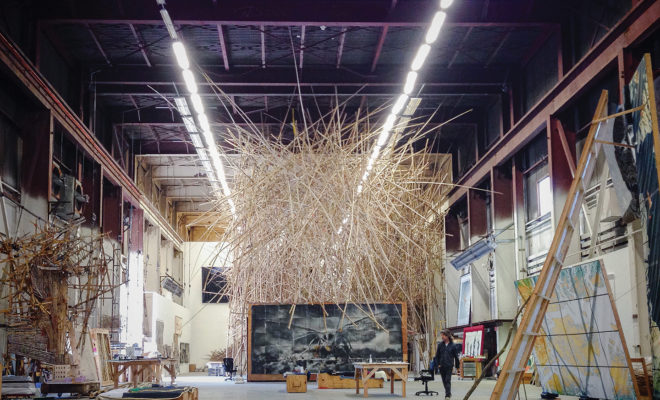
Feature
A Visit with the Starn Brothers at their Beacon Studio
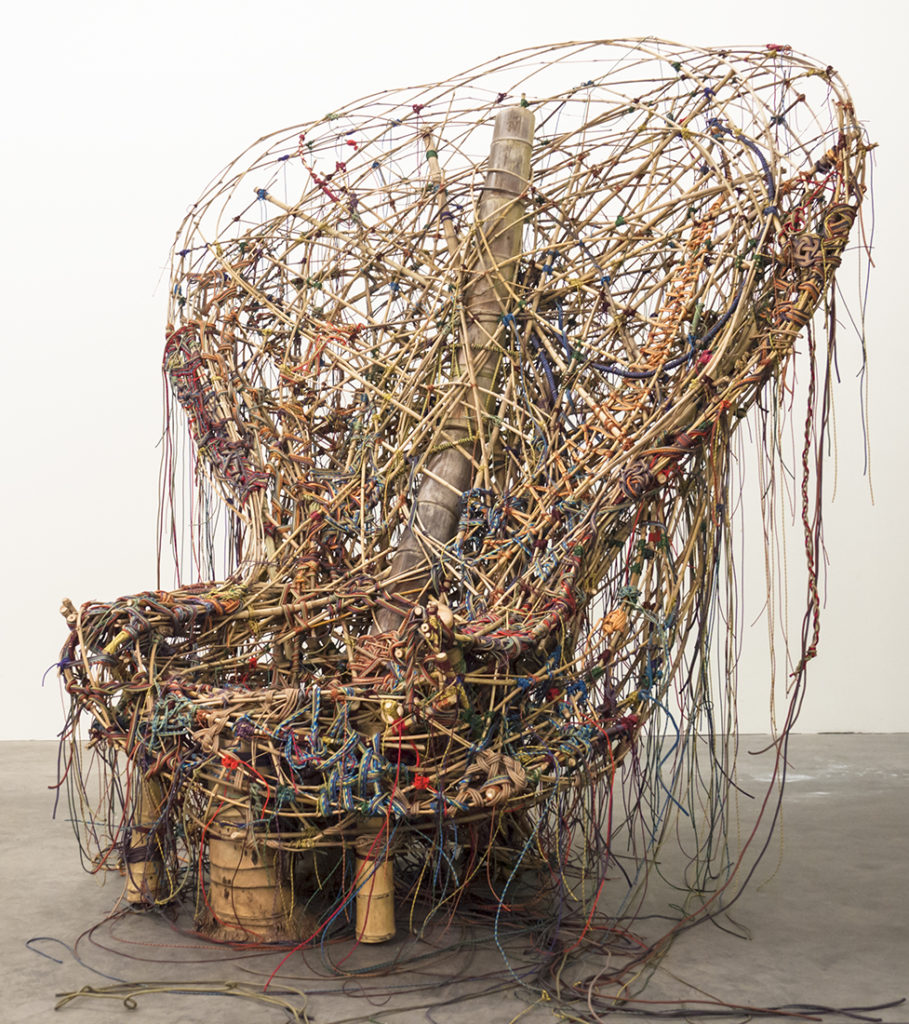
All the Nightmares Came Today, 2017, made of bamboo and rock climbing cord. Design pieces have always been built into the structure of the Big Bambú installations. Recently the Starn Brothers have begun making furniture sets that are more ornate and sold as private commissions. All photography courtesy of Doug and Mike Starn.
The exuberant voice of a young Bob Dylan singing “Like a Rolling Stone” came up on the soundtrack as I entered the Starn brothers’ Beacon studio. In their own way, Mike and Doug Starn have been exploring Dylan’s themes of impermanence, chaos, and interconnection since the mid-1980s, and the vast area of their renovated studio, once the Tallix Foundry, might be considered a laboratory for experiments in randomness and beauty.

(Any) Body Oddly Propped, 2015, made of glass, steel, and bronze, and installed. The six layered glass panels, each eighteen feet long, rest on the lawn at Princeton University, reflecting the interconnection of student life with the surrounding architecture, landscape, and trees.
The Starns, who transmit a concentrated and quiet but highly charged energy, have been making art collaboratively as long as they can remember. And, the phenomenon of being identical twins—connected through biology, memory, and imagination—suffuses their artistic ideas. Born near Atlantic City in 1961, both went to the School of the Museum of Fine Arts in Boston, where they were immersed in city’s post-punk culture. When they entered the art scene in the 1980s, they became known for collage-like photographic mosaics constructed from roughly cut or torn images, as simple as the cropped heads of horses, which they printed on silver gelatin papers, soaked in toner, and joined together with Scotch Tape. The work explores a theory of vision as something comprehended through perception. Gestural and raw, it is also delicately layered and has served as a foundation for everything they’ve done since. In fact, they talk about their art as a rhizomatic structure: “always finished, but never complete,” ideas translating project to project, regardless of medium or material.

Detail from the design piece So Swishy in her Satin and Tat (design piece), 2017, made of bamboo and rock climbing cord.

Starn Brothers’ Beacon studio showing panels from Shi-Tenno, the four heavenly kings or Buddhist protectors. The photographs are printed on Zerkall paper for a gilded effect. To the right, you can see Structure of Thought, showing silhouettes of trees, dating from 2001. The Starns translated their photographs of trees into fused glass panels, mosaic maps, and stainless steel fencing for their permanent installation at the South Ferry Station in 2008.
Big Bambú, the ongoing reinstallation of their 2008 architectural sculpture, takes up the largest share of the industrial section of their studio. The heroically scaled piece is made with thousands of densely stacked and crisscrossing bamboo canes connected with colored rock climbing cord. From a distance, it looks like a mountain of pick-up sticks dropped into a random jumble that nearly reaches the ceiling rafters. Because weight is distributed throughout the massive tangle of poles, it has enormous tensile strength. When you climb on it, you position your foothold the way you would on tree roots along the incline of a forest. About twelve local rock climbers comprise the studio’s building crew and perhaps three times that number might participate in the outside constructions, such as the one that was on the roof of the Metropolitan Museum of Art in the summer of 2010. The crew doesn’t work all the time but, when they come together, they start where they left off, shaping the thirty or forty-foot bamboo canes into a towering wave, rising and eventually dipping to the floor. After it touches ground, they dismantle the poles at the bottom of the wave, feeding them to the front and creating a new wave that goes three hundred feet in the other direction. On the day I visited, workers were lashing together loops of bamboo around the back of a peacock chair. Furniture has always been part of Big Bambú which is a habitable sculpture, and the design pieces, including a chaise lounge and coffee table with cup holders, look like well-worn porch furniture on steroids. Descending to the floor, the tangled web of caning seems like it came into the world half-disintegrated, purposefully fragmented, and perfectly imperfect. Gallerist Cristina Grajales exhibited the design pieces at Design Miami/ in December, and just this month, at Fog Design + Art in San Francisco.
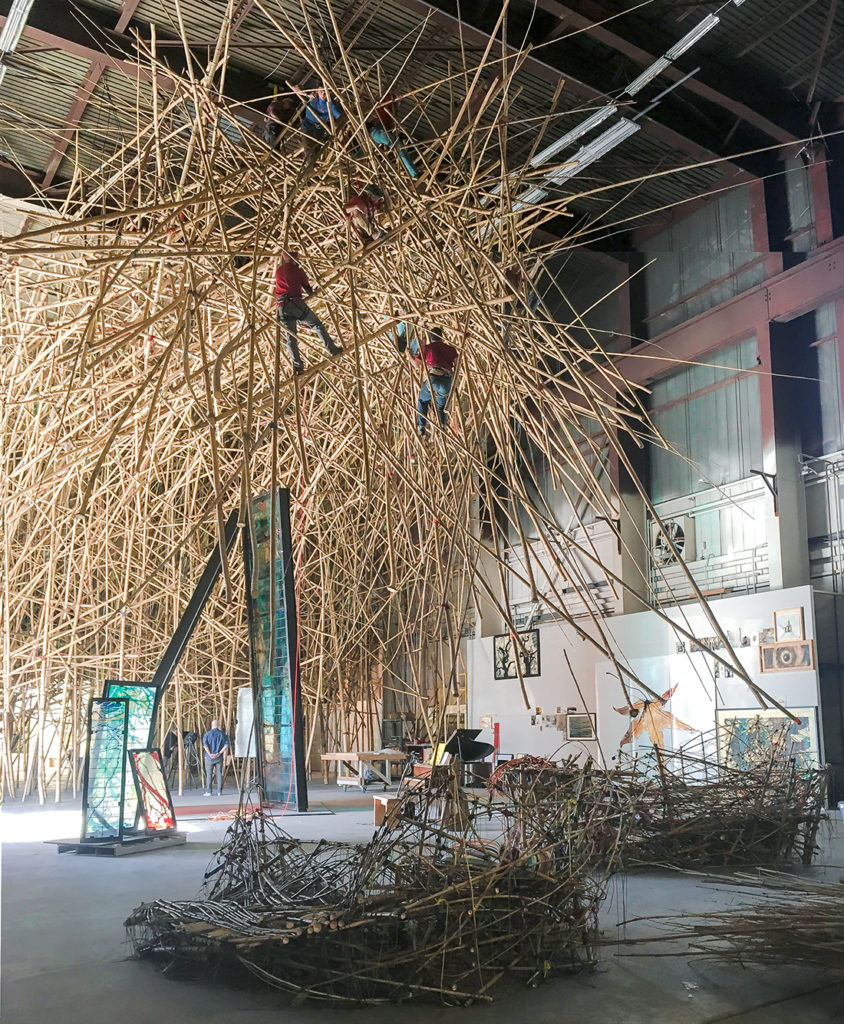
Crew Working on Big Bambú in the Beacon studio. Artist proofs of the Princeton glass panels stand in the foreground.
The state-of-the-art studio space serves as an archive where you can see past projects like the photographic images of the once-gilded statue of the blind monk Janjin or the silhouettes of gnarled trees. On the floor, an 11-foot-long photograph of Philippe de Champaigne’s dead Christ is situated across from scaffolding that supports an enormous model of the earth, twenty-two feet in diameter and built with tar and steel, Plexiglas, pipe clamps, and strips of toned gelatin silver film. The studio also houses proofs of recent and ongoing work such as the (Any) Body Oddly Propped located outside the Princeton Art Museum and the 90-foot-long stained glass wall recently installed at the American Embassy in Moscow, which was commissioned by Virginia Shore of Art in Embassies.
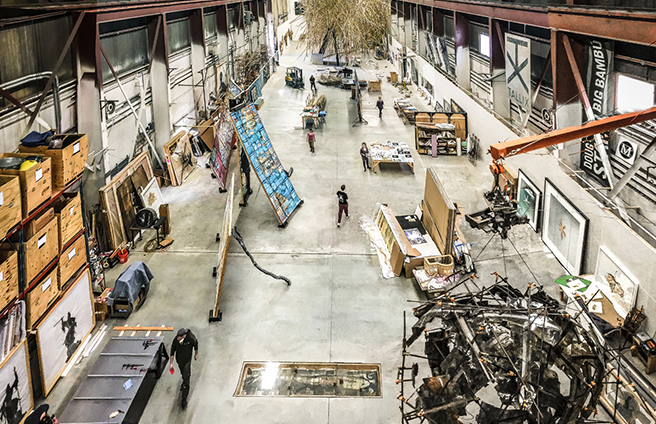
View of the Starn Brothers’ studio in Beacon, New York, formally the Tallix Foundry. The studio is 40,000 square feet all together with a 50 foot-high ceiling. The rotating sculpture, Sphere of Influence, 1991, is positioned in the foreground and Big Bambú stands in the distance.
With its layers of glass, capturing the light, the work for the embassy emblematizes the miraculous clarity of outer space. Honoring the shared exploration of the cosmos, the piece celebrates the spectrum of humanity captured in a portrait of the India–born American astronaut Kalpana Chawla positioned in the center of one of the panels. The image of Chawla, who flew two shuttle missions before perishing when the Columbia broke up on its reentry to the earth’s atmosphere, hovers like a Byzantine icon, absorbing the glowing spectral colors absorbed in the glass. You can read the text from the Velvet Underground overlaid on one of the related pieces: “Jenny said when she was just five years old/there was nothing happening at all…” The words continue past the refrain: “It was alright (it was alright) Hey baby, you know it was alright (it was alright).” As with Big Bambú, the transcribed lyrics acknowledge what the Starn brothers call the invisible architecture of life.
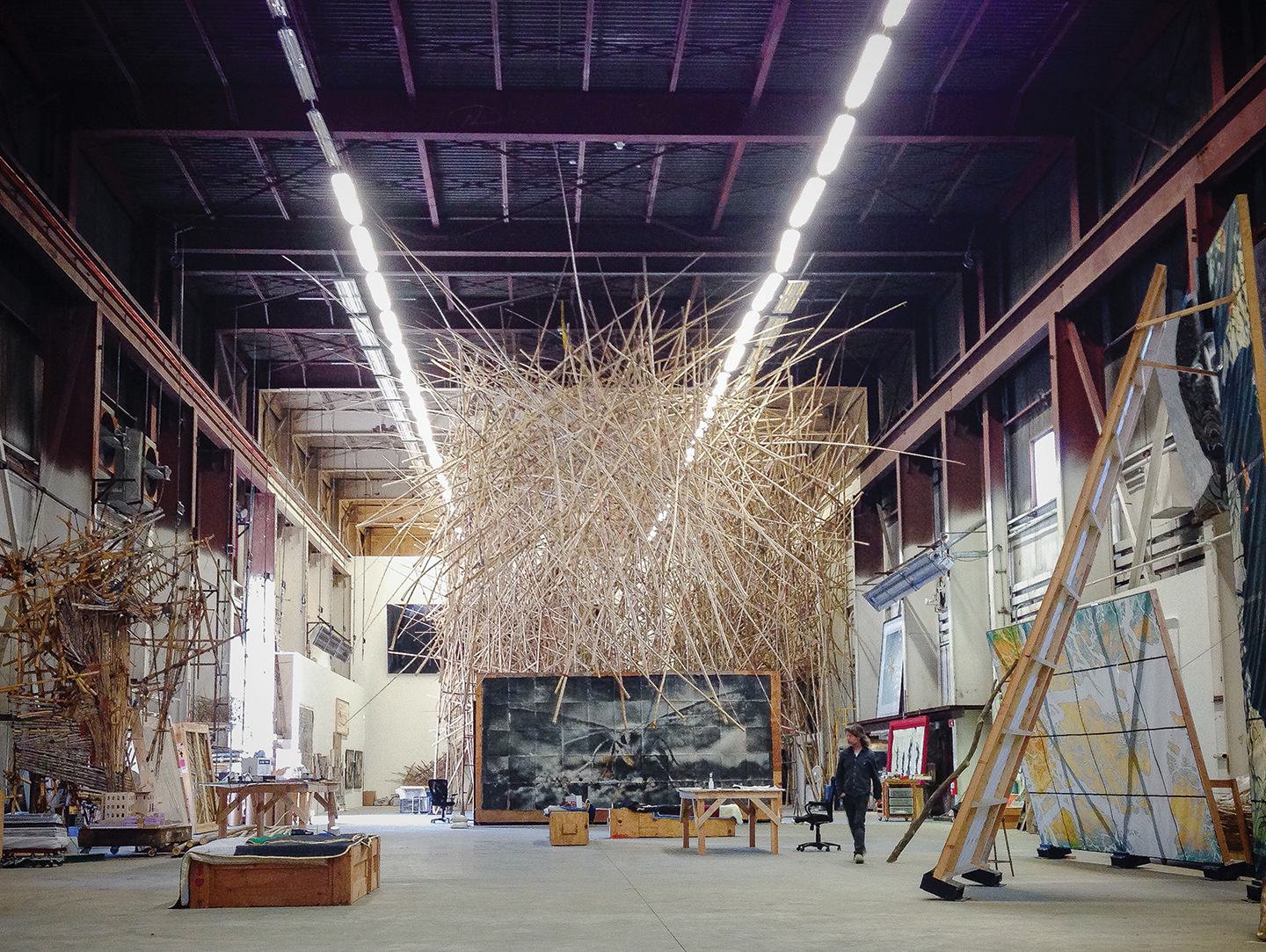
View of Starn Brothers’ Studio, showcasing panels from Attracted to Light 1, a series of photographic studies of moths that began in the late 1990s. The photos are printed on mulberry paper, hand-coated with felt, and immersed in sulfur toner in order to achieve a fragile and dusty quality like the wings of moths.









